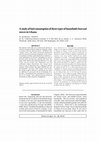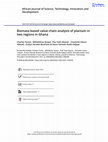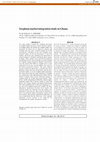Papers by Wilhemina Quaye
Lecture notes in civil engineering, 2024

Frontiers in education, Apr 23, 2024
Ghana has recently renewed its commitment to build a strong Science, Technology, and Innovation (... more Ghana has recently renewed its commitment to build a strong Science, Technology, and Innovation (STI) base for improved socio-economic development. This commitment hinges on recognizing that the strength of the nation's STI policy depends on the quality of pre-tertiary education and training in science and mathematics to produce a critical mass of young people well-prepared for Science, Technology, Engineering, and Mathematics (STEM) courses at the tertiary level. However, despite numerous interventions to improve upon STI, Ghana still performs poorly, along with other Sub-Sahara Africa (SSA) countries with common STI indicators in the Global Innovation Index. Using Ghana as a lens, this article highlights the challenges in STEM teaching and learning throughout the sub-region. The qualitative research approach was adopted to allow an in-depth exploration of participants' perspectives. Six pre-tertiary schools (three Junior High Schools and three Senior High Schools) and the University of Ghana, Legon, were selected due to the availability of their students and teachers to participate in the interviews in Accra, the capital city. This article argues that, to develop the critical mass of human capital needed for sustainable development, there is a need to improve the performance of students in STEM subjects at the pre-tertiary level. In addition, performance improvement, which is linked to student interest in the study of STEM subjects, should increase the quality of students entering tertiary education institutions. These students will then be trained to meet the quality of human resources needed to run the STI system-a step toward achieving sustainable development this article recommends the redesign of STEM curriculum at the pre-tertiary level to align with tertiary STEM education as that in turn aligns with Ghana's STI system.
Gates Open Res, Feb 15, 2019
, respectively, to assess their perceptions of various cassava processing technologies transferre... more , respectively, to assess their perceptions of various cassava processing technologies transferred under the Root and Tuber Improvement Programme. These technologies included production of high quality cassava flour (HQCF) and the use of improved stoves, graters, and presses for the production of "gari". To over 70 per cent of the respondents, the improved processing technologies were suitable to the village/community-based setting. However, the use of screw press was assessed to be labour-intensive, and lack of maintenance culture limited the efficiency of graters. Unearthing the opportunities in the cassava processing industry, small and large-scale linkages, and the use of intermediate processing options were thought necessary to meet local and export market demand. Original scientific paper.
Some of the authors of this publication are also working on these related projects: Empowering sm... more Some of the authors of this publication are also working on these related projects: Empowering small-scale farmers (SPEAR): towards the SDGs through participative, innovative and sustainable livestock and poultry value chains (LPVC) View project GRATITUDE View project
This paper reviews the concept of food sovereignty as an alternative to failing conventional food... more This paper reviews the concept of food sovereignty as an alternative to failing conventional food policies. Using the Ghanaian economy as a case study, it investigates the implications of food sovereignty for attaining the ambitious Millennium Development Goal (MDG) of combating poverty and hunger in developing economies. The need for social shaping of (bio)technologies have been emphasized. It has also been recommended that policies on support for small holder farmers in developing countries will have to be defensive and responsive to price-distorting subsidies. Not only should government be committed to promoting, defending and protecting the rights of local farmers and agricultural employees. Such policies should also consider technology-programs from food sovereignty perspective.

African Journal of Agricultural Research, May 31, 2008
This paper looks at the food security situation in three most deprived and poverty-stricken regio... more This paper looks at the food security situation in three most deprived and poverty-stricken regions in the Northern parts of Ghana and examines how farmer households cope during food insecure periods. The study concludes that although farmers in these regions cultivate purposely for household consumption and sell the surplus, food was not available throughout the year in the farmer households interviewed. On the average staple foods produced lasted for seven months. Coping mechanisms during months of inadequate household food provision included migration to southern Ghana for wage labor, support from relatives and friends outside the regions, sales from livestock and household valuables as well as reduction of food intake and consumption of less preferred food. Erratic rainfall patterns, high cost of agrochemicals, lack of knowledge on improved farming and post harvest practices as well as lack of production credit and markets for farm produce were some of the constraints militating against increased production and improvement in food security. Measures to remove these constraints will therefore go a long way to improve the household food security situation in Northern Ghana.

Ghana journal of agricultural science, Sep 21, 2009
The purpose of this study was to find out the amounts of charcoal consumed using the traditional ... more The purpose of this study was to find out the amounts of charcoal consumed using the traditional Ghanaian coalpot in contrast with two improved stoves, "Ahinbenso" and "Gyapa" stoves. The study covered 80 purposively selected charcoal-consuming households in the Greater Accra Region of Ghana. Each household was allowed a 1week measurement of charcoal consumption for each of the three stoves and data were analyzed with Excel. The study results showed fuel (charcoal) efficiency of 31 and 23 per cent for "Gyapa" and "Ahinbenso" over the traditional coalpot, respectively. The "Gyapa" stove saves 0.51 kg of charcoal per day or 186 kg of charcoal annually, which translates into about US$25.00 per year per household. For every 1,000 "Gyapa" stoves in use, the savings would be 186 tons of charcoal per year, equal to 1,488 tons of wood and 31.83 ha of forestland. It is, therefore, recommended that promotional activities on the use of "Gyapa" stove among charcoal-consuming households in Ghana should be strengthened.

The conversion of the kinetic energy in wind into electrical energy offers unique solution to the... more The conversion of the kinetic energy in wind into electrical energy offers unique solution to the overall energy supply where resource exists as well as partial solution to the world's over dependence on exhaustible primary energy sources such as fossil fuel and their consequences which include climate change, extinction of aquatic life during spillages and so on. The coastlines of Ghana present significant wind potential which when properly harnessed could provide alternative livelihood opportunities and speed up climate change adaptation processes in those communities hard-hit by climate change effects. To establish the technical and economic potential of wind resource for energy production and productive application, there is the need to investigate the baseline frameworks and use optimized wind energy tools to generate results for effective wind energy planning. Ground wind data search and analysis, overall energy situation and energy policy environment formed the core of establishing the technical potentials and economic opportunities of wind energy in the Dangbe East District. A wind data analysis was done to establish the wind energy potential and a survey identifies innovative mechanisms adopted for building resilience and tracks changes in behavioural practices to adapt to climate change effect. A total of 360 small-scale farmers were interviewed. Phenomenal changes in weather conditions and climate events observed by respondents include erratic and unpredictable rainfall patterns with poor distributions, high temperatures with hot sunshine conditions, drought and heavy precipitations/floods. Key innovative technologies employed to adapt to climate change effects include soil management practices that reduce fertilizer use and increase crop diversification; promotion of legumes in crop rotations; use of quality seeds and integrated crop/livestock systems; avoidance of bush burning as well as burning crop residues; introduction of drought, flood and saline-tolerant crops and using improved, high yielding and drought resistant varieties. Less than 30% of the farmers interviewed had relocated close to water bodies (River Volta), especially for minor season farming while 42% had diversified into other alternative livelihood options. Farmers strongly considered provision of irrigation services by government and non-governmental organisation, credit and availability of improved agro-technologies as well as education key in building resilience to climate change effects.

The conversion of the kinetic energy in wind into electrical energy offers unique solution to the... more The conversion of the kinetic energy in wind into electrical energy offers unique solution to the overall energy supply where resource exists as well as partial solution to the world's over dependence on exhaustible primary energy sources such as fossil fuel and their consequences which include climate change, extinction of aquatic life during spillages and so on. The coastlines of Ghana present significant wind potential which if properly harnessed could provide alternative livelihood opportunities and speed up climate change adaptation processes among those communities hard-hit by climate change effects. To establish the technical and economic potential of wind resource for energy production and productive application, there is the need to investigate the baseline frameworks and use optimized wind energy tools to generate results for effective wind energy planning. Ground wind data search and analysis, overall energy situation and energy policy environment formed the core of establishing the technical potentials and economic opportunities of wind energy in the Dangbe East District. A wind data analysis was done to establish the wind energy potential and a survey to identify innovative mechanisms adopted for building resilience and track changes in behavioural practices to adapt to climate change effect. Wind data covering a period of one year were analysed and interviews were conducted for a total of 360 small-scale farmers from 12 farming communities. Phenomenal changes in weather conditions and climate events observed by respondents include erratic and unpredictable rainfall patterns with poor distributions, high temperatures with hot sunshine conditions, drought and heavy precipitations/floods. Key innovative technologies employed to adapt to climate change effects include soil management practices that reduce fertilizer use and increase crop diversification; promotion of legumes in crop rotations; use of quality seeds and integrated crop/livestock systems; avoidance of bush burning as well as burning crop residues; introduction of drought, flood and saline-tolerant crops and using improved, high yielding and drought resistant varieties. Less than 30% of farmers interviewed had relocated close to water bodies (River Volta), especially for minor season farming while 42% had diversified into other alternative livelihood options. Farmers strongly considered provision of irrigation services by government and non-governmental organisation, credit and availability of improved agro-technologies as well as education key in building resilience to climate change effects.

Journal of agricultural science, Feb 4, 2010
This study assessed the perceptions of stakeholders concerning implementation activities of a Foo... more This study assessed the perceptions of stakeholders concerning implementation activities of a Food Security and Rice Producers Organisation Project (FSRPOP) in Northern Ghana. The project aimed at building the capacities of farmer based organisations (FBOs) to assist rice farmers access credit, organise production inputs and improve market access. The study results showed that although access to input supply and production credit improved, enhancing farmers' marketing capacity was not successful. The management capacity of the FBOs was weak in performing more complex administrative issues and market facilitating roles. Timely provision of production inputs, use of custom based processing and credit inventory system for maximum profit were some of the lessons learnt. Facilitation of farmermedium scale buyer linkages and the development of lessons-based action plan for change with beneficiaries were recommended

African Journal of Science, Technology, Innovation and Development, 2015
A total of 231 cocoa farmers were interviewed through a structured survey in selected districts i... more A total of 231 cocoa farmers were interviewed through a structured survey in selected districts in the Eastern, Ashanti, Brong Ahafo and Western regions of Ghana to explore their views on how the existing land tenurial arrangement incentivise sustainable cocoa production practices. In addition, 12 key informant interviews and six focus group discussions were held. The composition of focus group discussions ranged between 14 and 26 cocoa farmers. Survey findings revealed that increasing cocoa production through farm expansion is no longer an option but the challenge is to meet the dual goal of environmental sustainability and improvement of farmers' welfare through the adoption of sustainable production practices. Survey findings confirmed that the existing land tenurial arrangements need to be improved in order to incentivise farmers in Ghana to adopt environmentally sustainable production practices. Farmers and other stakeholders suggested that the development of a land policy for cocoa farming that ensures proper documentation and formalisation of tenurial systems with clear benefit sharing agreements, education on land registration and proper acquisition of land and resolution of land disputes will incentivise the adoption of environmentally sustainable practices, among others.
Journal of the Ghana Science Association, 2001

International Journal of Consumer Studies, 2010
The objective of this study was to examine the effect of global–local interactions on food produc... more The objective of this study was to examine the effect of global–local interactions on food production and consumption in Ghana, and identify possible local solutions. Primary data were collected using a combination of quantitative‐qualitative methods, which included focus group discussions and one‐on‐one interviews. Approximately 450 household heads were randomly selected and interviewed between August 2007 and August 2008 in Eastern, Central, Upper East and Northern Regions of Ghana. Findings revealed increasing consumption of foreign rice as opposed to decreasing consumption of local rice and other staples like millet, sorghum and yam because of global–local interactions. However, opportunities exist to re‐localize production‐consumption patterns through the use of ‘glocal foods’ like improved ‘koose and waakye’. Referencing the situation in Ghana, the study recommends improved production and processing practices backed with appropriate technologies that reflect changing consumpti...

Food Chain, 2015
This study analysed gender dimensions of decision-making at the household level in cassava enterp... more This study analysed gender dimensions of decision-making at the household level in cassava enterprise in Ghana, Nigeria, and Vietnam in the context of risks and benefits to food security to ensure value addition to reduce post-harvest losses from cassava. Rapid participatory rural appraisal was used to select a total of 501 households in the countries chosen for this study. Focus and group discussions (F and GD) and semi-structured questionnaires were used to collect primary data. Data were analysed descriptively. Twenty cassava-based activities linked to gender activities in cassava processing households in the selected countries were identified. In all three countries, final decisions to allocate and use resources were taken by men – although women are commonly responsible for post-harvest management. Ownership of production and processing assets is positively skewed to men across the sample with women having rights of use only. Household decision-making objectives for generating peels and attitudes tow...

African Journal of Science, Technology, Innovation and Development, 2020
Plantain biomass value chain analysis was conducted to generate benchmark information that suppor... more Plantain biomass value chain analysis was conducted to generate benchmark information that supports reduction of postharvest losses of plantain and to identify value-added opportunities and linkages to new markets in Ghana. Specifically, this study sought to identify the actors and their roles along the plantain value chain, understand the plantain value chain activities and identify biomass value addition opportunities that will help reduce post-harvest losses of plantain. Using the value chain analysis approach a total of 309 plantain value chain actors including producers, processors, traders, caterers and consumers in the Brong Ahafo and Western regions of Ghana were interviewed. Post-harvest losses of 20% at the production, 15% at the market levels and less than 5% at the consumption level were revealed. Plantains were traded mostly in the unprocessed form and 83% farmer respondents sold plantain unprocessed. The cross-cutting constraints among the actors were inadequate credit accessibility, high transportation cost, limited processing capacities, seasonality of plantains and fluctuation in prices, marketing challenges and post-harvest losses among others. The study provides useful baseline information for new products development from the biomass along the plantain value chain.

Ghana Journal of Agricultural Science, 2009
The study sought to examine the variability and trends in sorghum supply and prices, factors affe... more The study sought to examine the variability and trends in sorghum supply and prices, factors affecting volumes of sorghum traded, and whether the sorghum market was integrated. To achieve the set objectives, primary and secondary data were used. A random sample size of 160 respondents, including 20 per cent sorghum grain itinerant traders, 43 per cent wholesalers, 17 per cent retailers, and 20 per cent consumers were interviewed in selected markets in Northern and Brong Ahafo regions in Ghana. These markets were selected by production and utilization levels, and accessibility as well as potential for sorghum market expansion. Monthly observations over the period 1990-1999 on sorghum prices at the wholesale level for the selected markets were used for the market integration analysis. The study adopted various analytical approaches, including the basic Ravallion model with some modifications and the Error Correction model, to test for sorghum market integration. The study showed that the actual marketing of sorghum was organized by many individual private traders with no barrier to market entry. Factors affecting volumes of sorghum traded are variable and location-specific. These factors include transportation difficulties, limited supply, inadequate capital, lack of finance, number of sellers and buyers, risk of price changes, and quality deterioration. The study established lack of short-run integration in 75 per cent of the sorghum market pairs studied. The price adjustment mechanism between local market and reference market was relatively slow, but markets were integrated in the long run. This could be attributed to lack of an adequate market information system at the rural markets, and possibly transportation difficulties. It was recommended that the efficiency of the sorghum marketing system needed to be improved by strengthening the market information system.











Uploads
Papers by Wilhemina Quaye